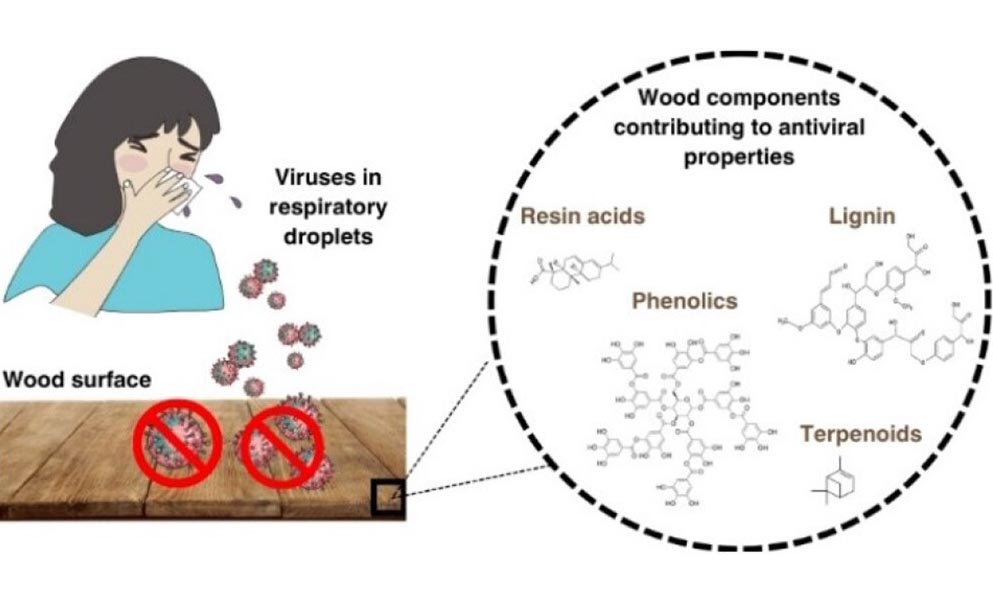Scientist from Finland discover that wood surfaces can curb COVID-19 transmission
Nikhil Prasad Fact checked by:Thailand Medical News Team Sep 02, 2024 1 year, 3 months, 1 week, 4 days, 12 hours, 41 minutes ago
In the ongoing battle against viral transmission, including COVID-19, new research suggests that certain wood surfaces may naturally reduce the risk of virus spread. This
Medical News report explores a groundbreaking study conducted by researchers from the University of Jyväskylä in Finland and the University of Eastern Finland, who have discovered that wood possesses inherent antiviral properties that could make it an effective material for mitigating surface transmission of viruses like the coronavirus.
 Graphical Abstract. Scientist from Finland discover that wood surfaces can curb COVID-19 transmission
Understanding the Antiviral Properties of Wood
Graphical Abstract. Scientist from Finland discover that wood surfaces can curb COVID-19 transmission
Understanding the Antiviral Properties of Wood
Viruses can linger on surfaces for extended periods, contributing to the spread of diseases such as COVID-19. While traditional disinfectants are commonly used to neutralize pathogens on surfaces, these chemicals can have adverse environmental and health effects with prolonged use. This study highlights the potential of wood as a natural, sustainable solution.
The research team, led by Varpu Marjomäki from the Department of Biological and Environmental Sciences at the University of Jyväskylä, investigated the antiviral properties of various wood species, including Scots pine, Norway spruce, silver birch, gray alder, eucalyptus, and pedunculate oak. The study focused on both enveloped viruses, like the coronavirus, and nonenveloped viruses, such as the enterovirus, to determine how long these viruses remained infectious on different wood surfaces.
Research Methodology and Findings
The researchers applied droplets containing viruses to wood samples and monitored how long the viruses remained active. They used two cell lines, MRC-5 and A549, to measure viral infectivity after different incubation periods.
The results were striking. Scots pine and Norway spruce showed the fastest antiviral activity against the enveloped coronavirus, reducing viral infectivity within just 5 to 10 minutes. Other woods, such as birch and alder, also demonstrated antiviral properties, though to a lesser extent. Interestingly, eucalyptus and oak required longer incubation periods, up to two hours, to achieve a similar reduction in viral activity.
When it came to nonenveloped viruses like the enterovirus, oak and spruce surfaces showed a significant reduction in viral infectivity within an hour, with oak demonstrating an onset time of 7.5 minutes. On the other hand, woods like pine and birch took about four hours to achieve a similar effect, while alder showed no antiviral effect.
The study's findings underscore the importance of the chemical composition of wood in determining its antiviral functionality. Pine and spruce, in particular, were found to contain resin acids and terpenes, which are believed to contribute to their strong antiviral activity. Oak’s high phenolic content was associated with its effectiveness against the enterovirus.
The Role of Environmental Conditions
To better understand how environmental factors influence the antiviral properties o
f wood, the researchers examined the effects of temperature and humidity. They found that higher temperatures, such as 37°C, enhanced the antiviral activity of wood surfaces. For instance, the eucalyptus surface completely inactivated the virus after one hour at 37°C, but the virus remained infectious at lower temperatures.
Interestingly, relative humidity (RH) played a minor role in virus inactivation. While variations in RH from 20% to 90% showed some influence at higher temperatures, the relationship between humidity and viral infectivity was not straightforward. This suggests that temperature is a more critical factor in determining the efficacy of wood as an antiviral material.
Chemical Analysis of Wood Surfaces
The researchers conducted a chemical analysis of the wood surfaces to identify the compounds responsible for their antiviral activity. They found that the most effective woods, like pine and spruce, emitted a variety of volatile organic compounds (VOCs), including resin acids, phenolic compounds, and hydrocarbons. These chemicals are believed to play a crucial role in inactivating viruses on the wood surface.
Further analysis revealed that thermal treatment of wood, commonly used to enhance durability, could significantly alter its antiviral properties. For example, thermally treated spruce, subjected to higher temperatures, lost much of its antiviral efficacy, suggesting that the treatment process could degrade the active compounds responsible for virus inactivation.
Implications for Public Health and Sustainable Design
The findings of this study have significant implications for public health and sustainable design. The use of wood surfaces in high-contact environments, such as hospitals, schools, and public transportation, could help reduce the transmission of viruses without relying on synthetic disinfectants. Moreover, wood’s natural antiviral properties offer a sustainable alternative that aligns with environmental and health considerations.
The study also opens up new avenues for research into the development of wood-based antiviral materials. By identifying and harnessing the chemical compounds responsible for wood’s antiviral activity, it may be possible to create coatings or treatments that enhance the effectiveness of wood surfaces in preventing viral transmission.
Conclusion
This study provides compelling evidence that certain wood species possess natural antiviral properties that can reduce the risk of viral transmission, including COVID-19. The findings highlight the potential of wood as a sustainable, biodegradable material for use in public health strategies aimed at curbing the spread of infectious diseases.
As we continue to face the challenges of viral outbreaks, the discovery of wood’s antiviral properties offers a promising path forward. Future research will focus on identifying the specific compounds responsible for this activity and exploring how wood surfaces can be optimized for maximum antiviral efficacy.
The study findings were published in the peer-reviewed journal: ACS Applied Materials & Interfaces.
https://pubs.acs.org/doi/10.1021/acsami.4c02156
For the latest COVID-19 News, keep on logging to Thailand
Medical News.
Read Also:
https://www.thailandmedical.news/news/ige-antibodies-found-to-play-a-role-following-both-natural-infection-and-various-types-of-covid-19-vaccinations
https://www.thailandmedical.news/news/breaking-brazilian-study-reveals-potential-impact-of-covid-19-on-babies-vision 